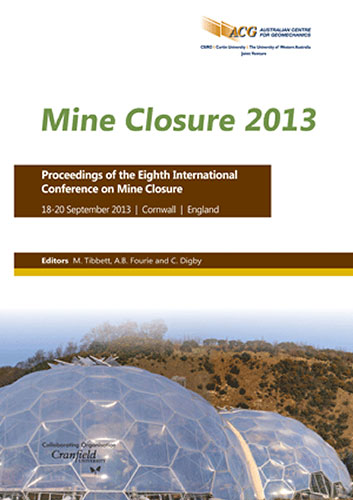The passive treatment of toe seepages from a reclaimed waste rock dump at Iduapriem Mine, Ghana

|
Authors: Williams, C; Dey, M; Mutambanegwe, C; Addo, W; Bruce, C |
DOI https://doi.org/10.36487/ACG_rep/1352_21_Williams
Cite As:
Williams, C, Dey, M, Mutambanegwe, C, Addo, W & Bruce, C 2013, 'The passive treatment of toe seepages from a reclaimed waste rock dump at Iduapriem Mine, Ghana', in M Tibbett, AB Fourie & C Digby (eds), Mine Closure 2013: Proceedings of the Eighth International Seminar on Mine Closure, Australian Centre for Geomechanics, Cornwall, pp. 251-264, https://doi.org/10.36487/ACG_rep/1352_21_Williams
Abstract:
Following the successful reclamation and closure of waste rock dump number 1 at the AngloGold Ashanti Iduapriem Limited mine, Tarkwa, Ghana, a number of toe seepages were observed. These seepages are characterised by low pH (5.0) and elevated levels of metals, most notably manganese at ~22 mg/L. After a period of monitoring, the Ghanaian Environmental Protection Agency requested that the seepages be treated prior to discharge to the local environment. In order to meet this requirement, the Iduapriem mine contracted SRK Consulting (UK) Ltd to undertake an assessment of the problem. The seepages coming from the waste rock dump (WRD) are ongoing year-round, but the flows vary in response to rainfall, which falls on the WRD and leaches through the dump to produce the seepage. Being in the tropics, the Ghanaian climate is typified by two long wet seasons and one dry season. Typically the seepage flows are of the order of ~20 L/s in the dry season and rise in the wet seasons to between 80 L/s and 100 L/s. After reviewing options on-site, SRK recommended that a passive treatment scheme was the most cost-effective solution for containment of the problem. This also ties in well with the long-term closure strategy for the mine, currently planned for post-2025. The passive treatment system consists of three treatment cells, all containing locally sourced materials. The first cell utilises the local lateritic soils as a source of iron, to aid in the removal of heavy metals and as a natural adsorbent. The second cell then neutralises the seepage with limestone while maintaining an anoxic zone with poultry manure. The third cell utilises charcoal and lateritic soil to polish the discharge effluent. Laboratory-scale tests confirmed the suitability of the materials to treat the seepages and predicted a discharge at slightly alkaline pH, with a manganese value below the required limit 0.1 mg/L. This paper presents the ongoing results of the passive treatment scheme and explains the processes utilised within each cell to aid in the treatment of the water.
References:
AGA (AngloGold Ashanti) (2012) Corporate Government and Policy, viewed 8 November 2012, /0/EnvironmentalandCommunityPolicy.pdf.
Ghana EPA (Environmental Protection Agency) (2010) Water Quality Guidelines, viewed 11 April 2013, .
GWC (Ghana Water Company) (1998) Ghana Standards 175 Part 1:1998, Water Quality – Requirement for Drinking Water.
Metcalf & Eddy, Inc. (2004) Wastewater Engineering, Treatment and Reuse, McGraw Hill Higher Education.
Phillips, P., Bender, J., Simms, R., Rodriguez-Eaton, S. and Britt, C. (1995) Manganese removal from acid coal-mine drainage by a pond containing green algae and microbial mat, Water Science and Technology, Vol. 31(12), pp. 161–170.
Younger, P.L., Banwart S.A. and Hedin, R.S. (2002) Mine Water – Hydrology, Pollution, Remediation, Kluwer Academic Publishers.
WHO (World Health Organization) (2011) Guidelines for Drinking Water Quality, 4th edition, Geneva.
© Copyright 2025, Australian Centre for Geomechanics (ACG), The University of Western Australia. All rights reserved.
View copyright/legal information
Please direct any queries or error reports to repository-acg@uwa.edu.au
View copyright/legal information
Please direct any queries or error reports to repository-acg@uwa.edu.au